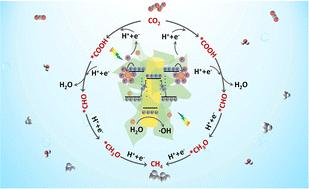当前位置:
X-MOL 学术
›
Inorg. Chem. Front.
›
论文详情
Our official English website, www.x-mol.net, welcomes your
feedback! (Note: you will need to create a separate account there.)
Synergetic effects of surface plasmon resonance and structure defects in a ZnCdS2/NiMoO4@Cu Z-scheme heterojunction for enhanced photocatalytic CO2 reduction to CH4
Inorganic Chemistry Frontiers ( IF 6.1 ) Pub Date : 2024-11-18 , DOI: 10.1039/d4qi02332c Zhentao Hu, Lei Huang, Bojing Sun, Dongfang Hou, Xiu-qing Qiao, Meidi Wang, Huijuan Ma, Dong-Sheng Li
Inorganic Chemistry Frontiers ( IF 6.1 ) Pub Date : 2024-11-18 , DOI: 10.1039/d4qi02332c Zhentao Hu, Lei Huang, Bojing Sun, Dongfang Hou, Xiu-qing Qiao, Meidi Wang, Huijuan Ma, Dong-Sheng Li

|
Photocatalytic carbon dioxide reduction to solar fuels is one of the promising strategies to solve resource depletion and global climate warming. Nevertheless, the poor product selectivity greatly limits its practical application. Herein, we present a Cu nanoparticle-modified ZnCdS2/NiMoO4 Z-scheme heterojunction photocatalyst that is highly selective and stable. It is worth noting that the hydrophobicity of NiMoO4 can effectively inhibit the adsorption of water while forming a Z-scheme heterostructure with defective ZnCdS2, and thus inhibiting hydrogen evolution and improving the separation efficiency of photogenerated carriers. Moreover, Cu nanoparticles with their surface plasmon resonance effect generate high-energy hot electrons during photoexcitation. This not only greatly increases the photogenerated electron density on the surface of the catalyst, resulting in a higher probability of multiple electron reactions or reduced state products but also effectively reduces the activation energy barrier for CO2 reduction through the photothermal effect. Consequently, the ZCS/NMO@Cu Z-scheme heterojunction exhibits nearly 100% selectivity for CH4 in the eight-electron reduction reaction, and outstanding CH4 yield of 92.17 μmol g−1 h−1 without a sacrificial agent and co-catalyst. Furthermore, the CO2 reduction mechanism is confirmed via in situ Fourier transform infrared (FTIR) spectroscopy analysis. This work will provide meaningful insights for designing a carbon dioxide reduction photocatalyst with high conversion and selection.
中文翻译:

ZnCdS2/NiMoO4@Cu Z 型异质结中表面等离子体共振和结构缺陷的协同效应,用于增强光催化 CO2 还原为 CH4
光催化二氧化碳还原为太阳能燃料是解决资源枯竭和全球气候变暖的有前途的策略之一。然而,较差的产品选择性极大地限制了其实际应用。在此,我们提出了一种 Cu 纳米颗粒改性的 ZnCdS2/NiMoO4 Z 型异质结光催化剂,它具有很高的选择性和稳定性。值得注意的是,NiMoO4 的疏水性可以有效抑制水的吸附,同时与有缺陷的 ZnCdS2 形成 Z 型异质结构,从而抑制析氢,提高光生载流子的分离效率。此外,Cu 纳米颗粒凭借其表面等离子体共振效应在光激发过程中产生高能热电子。这不仅大大增加了催化剂表面的光生电子密度,导致多个电子反应或还原态产物的概率更高,而且通过光热效应有效降低了 CO2 还原的活化能屏障。因此,ZCS/NMO@Cu Z 型异质结在八电子还原反应中对 CH4 表现出近 100% 的选择性,在没有牺牲剂和助催化剂的情况下,CH4 产率高达 92.17 μmol g-1 h-1。此外,通过原位傅里叶变换红外 (FTIR) 光谱分析证实了 CO2 还原机制。 这项工作将为设计具有高转化率和选择性的二氧化碳还原光催化剂提供有意义的见解。
更新日期:2024-11-18
中文翻译:

ZnCdS2/NiMoO4@Cu Z 型异质结中表面等离子体共振和结构缺陷的协同效应,用于增强光催化 CO2 还原为 CH4
光催化二氧化碳还原为太阳能燃料是解决资源枯竭和全球气候变暖的有前途的策略之一。然而,较差的产品选择性极大地限制了其实际应用。在此,我们提出了一种 Cu 纳米颗粒改性的 ZnCdS2/NiMoO4 Z 型异质结光催化剂,它具有很高的选择性和稳定性。值得注意的是,NiMoO4 的疏水性可以有效抑制水的吸附,同时与有缺陷的 ZnCdS2 形成 Z 型异质结构,从而抑制析氢,提高光生载流子的分离效率。此外,Cu 纳米颗粒凭借其表面等离子体共振效应在光激发过程中产生高能热电子。这不仅大大增加了催化剂表面的光生电子密度,导致多个电子反应或还原态产物的概率更高,而且通过光热效应有效降低了 CO2 还原的活化能屏障。因此,ZCS/NMO@Cu Z 型异质结在八电子还原反应中对 CH4 表现出近 100% 的选择性,在没有牺牲剂和助催化剂的情况下,CH4 产率高达 92.17 μmol g-1 h-1。此外,通过原位傅里叶变换红外 (FTIR) 光谱分析证实了 CO2 还原机制。 这项工作将为设计具有高转化率和选择性的二氧化碳还原光催化剂提供有意义的见解。






























 京公网安备 11010802027423号
京公网安备 11010802027423号